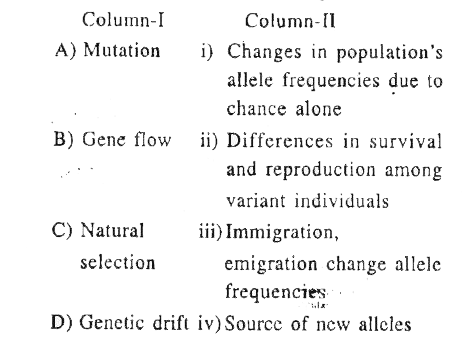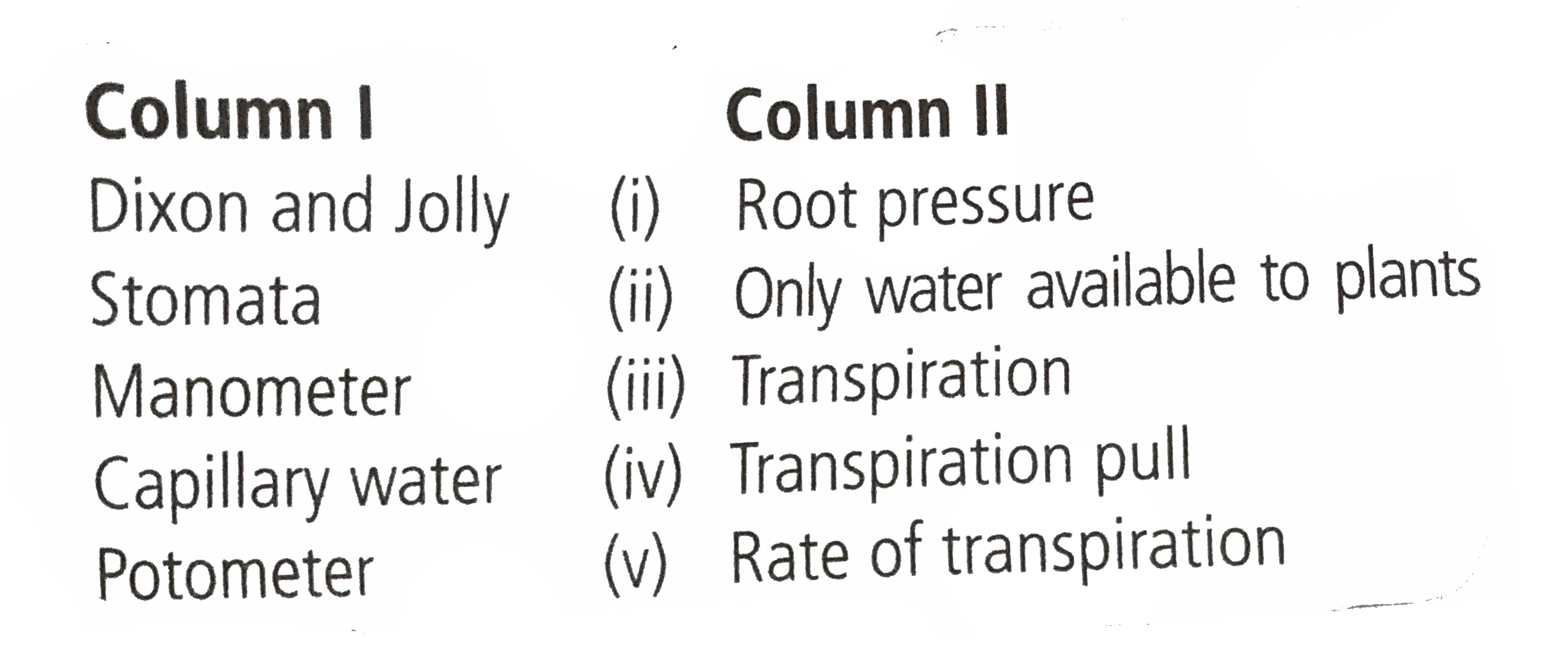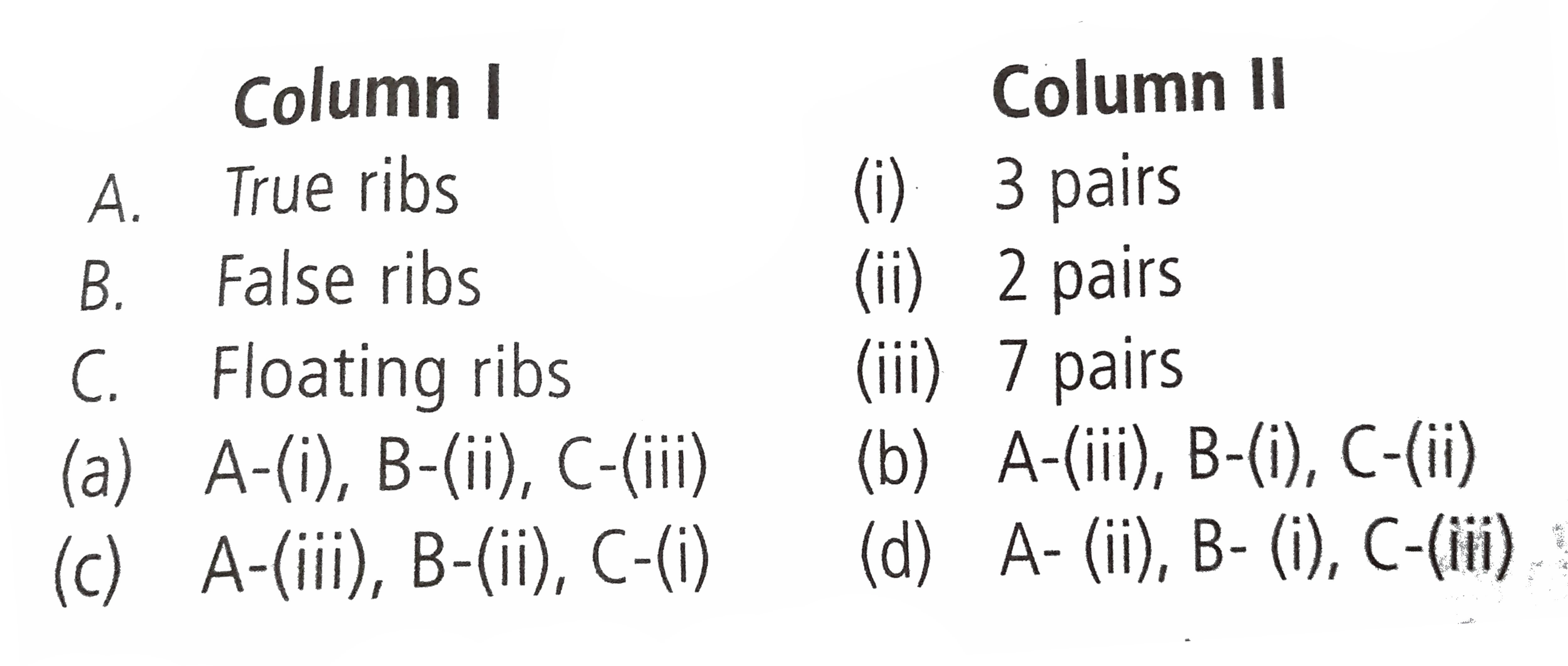Match column I with column II and select the correct option from the given codes
Column IColumn IIA.Autopolyploidy(i)2n+1B.Trisomy(ii)AAAAC.Allopolyploidy(iii)AABBD.Nullisomy(iv)2n-2
A-(ii),B-(i),C-(iii),D-(iv)
A-(iv),B-(i),C-(ii),D-(iii)
A-(ii),B-(iv),C-(iii),D-(i)
A-(ii),B-(i),C-(iv),D-(iii)
The correct Answer is:A
To solve the problem of matching Column I with Column II, we will analyze each term in Column I and find its corresponding match in Column II.
1. Understanding Autopolyploidy (A):
- Autopolyploidy refers to a condition where an organism has more than two sets of chromosomes derived from a single species.
- This can be represented as "AAAA" or "4n" (where n is the basic number of chromosomes).
- Match: Autopolyploidy (A) → (ii) AAAA
2. Understanding Trisomy (B):
- Trisomy is a genetic disorder where there is an extra chromosome, leading to a total of 47 chromosomes instead of the normal 46.
- This can be expressed as "2n + 1" (where n is the haploid number of chromosomes).
- Match: Trisomy (B) → (i) 2n + 1
3. Understanding Allopolyploidy (C):
- Allopolyploidy occurs when an organism has multiple sets of chromosomes from different species, resulting in a hybrid genome.
- This can be represented as "AABB" (indicating two different genomes).
- Match: Allopolyploidy (C) → (iii) AABB
4. Understanding Nullisomy (D):
- Nullisomy is the absence of both chromosomes of a homologous pair, resulting in a total of 2n - 2 chromosomes.
- Match: Nullisomy (D) → (iv) 2n - 2
Final Matches:
- A → (ii) AAAA
- B → (i) 2n + 1
- C → (iii) AABB
- D → (iv) 2n - 2
Conclusion:
The correct matches are:
- A (Autopolyploidy) → (ii) AAAA
- B (Trisomy) → (i) 2n + 1
- C (Allopolyploidy) → (iii) AABB
- D (Nullisomy) → (iv) 2n - 2
Selected Option:
The correct option from the given codes is:
- A → (ii), B → (i), C → (iii), D → (iv)
---
- Autopolyploidy refers to a condition where an organism has more than two sets of chromosomes derived from a single species.
- This can be represented as "AAAA" or "4n" (where n is the basic number of chromosomes).
- Match: Autopolyploidy (A) → (ii) AAAA
- Trisomy is a genetic disorder where there is an extra chromosome, leading to a total of 47 chromosomes instead of the normal 46.
- This can be expressed as "2n + 1" (where n is the haploid number of chromosomes).
- Match: Trisomy (B) → (i) 2n + 1
- Allopolyploidy occurs when an organism has multiple sets of chromosomes from different species, resulting in a hybrid genome.
- This can be represented as "AABB" (indicating two different genomes).
- Match: Allopolyploidy (C) → (iii) AABB
- Nullisomy is the absence of both chromosomes of a homologous pair, resulting in a total of 2n - 2 chromosomes.
- Match: Nullisomy (D) → (iv) 2n - 2
- A → (ii) AAAA
- B → (i) 2n + 1
- C → (iii) AABB
- D → (iv) 2n - 2
The correct matches are:
- A (Autopolyploidy) → (ii) AAAA
- B (Trisomy) → (i) 2n + 1
- C (Allopolyploidy) → (iii) AABB
- D (Nullisomy) → (iv) 2n - 2
The correct option from the given codes is:
- A → (ii), B → (i), C → (iii), D → (iv)
Topper's Solved these Questions
- PRINCIPLES OF INHERITANCE & VARIATIONBOOK - NCERT FINGERTPS ENGLISHCHAPTER - PRINCIPLES OF INHERITANCE & VARIATIONEXERCISE - HOTS
5 Videos
- PRINCIPLES OF INHERITANCE & VARIATIONBOOK - NCERT FINGERTPS ENGLISHCHAPTER - PRINCIPLES OF INHERITANCE & VARIATIONEXERCISE - EXEMPLAR
17 Videos
- PRACTICE PAPERSBOOK - NCERT FINGERTPS ENGLISHCHAPTER - PRACTICE PAPERSEXERCISE - Practice paper
150 Videos
- REPRODUCTION IN ORGANISMBOOK - NCERT FINGERTPS ENGLISHCHAPTER - REPRODUCTION IN ORGANISMEXERCISE - All Questions
137 Videos
Similar Questions
Match Column-I with Column-II and select the correct option from the codes given below.

View SolutionMatch Column -I with column-II and select the CORRECT option from the codes given below .
Column - IColumn - II(P) Autopolypoidy(i)2n+1(Q) Trisomy(ii)AAAA(R) Allopolyploidy(iii)AABB(S) Nullisomy(iv)2n−2
View Solution
Knowledge Check
Match column I with II column II and select the correct option from the given codes .
 AA-(ii), B-(iii), C-(iv), D-(i)BA-(iii), B-(ii), C-(i), D-(iv)CA-(iii), B-(ii), C-(iv), D-(i)DA-(i), B-(ii), C-(iii), D-(iv)
AA-(ii), B-(iii), C-(iv), D-(i)BA-(iii), B-(ii), C-(i), D-(iv)CA-(iii), B-(ii), C-(iv), D-(i)DA-(i), B-(ii), C-(iii), D-(iv)Match columnI with column II and select the correct option from the codes given below.
 AA−(iv),B−(iii),C−(v),D−(ii),E−(i)BA−(i),B−(iii),C−(iv),D−(ii),E−(v)CA−(iv),B−(iii),C−(i),D−(ii),E−(v)DA−(v),B−(iv),C−(iii),D−(ii),E−(i)
AA−(iv),B−(iii),C−(v),D−(ii),E−(i)BA−(i),B−(iii),C−(iv),D−(ii),E−(v)CA−(iv),B−(iii),C−(i),D−(ii),E−(v)DA−(v),B−(iv),C−(iii),D−(ii),E−(i)Match column I with column II and select the correct option from the codes given below.
 AA-(i), B-(ii), C-(iii)BA-(iii), B-(i), C-(ii)CA-(iii), B-(ii), C-(i)DA-(ii), B-(i), C-(iii)
AA-(i), B-(ii), C-(iii)BA-(iii), B-(i), C-(ii)CA-(iii), B-(ii), C-(i)DA-(ii), B-(i), C-(iii)
Match column I with column II and select the correct option from the codes given below.

View SolutionMatch column I with column II and select the correct option from the codes given below.

View SolutionMatch column I and II and select the correct option from the given codes.

View SolutionMathc column I with column II and select the correct option from the given codes.

View SolutionMathc column I with column II and select the correct option from the given codes.

View Solution
